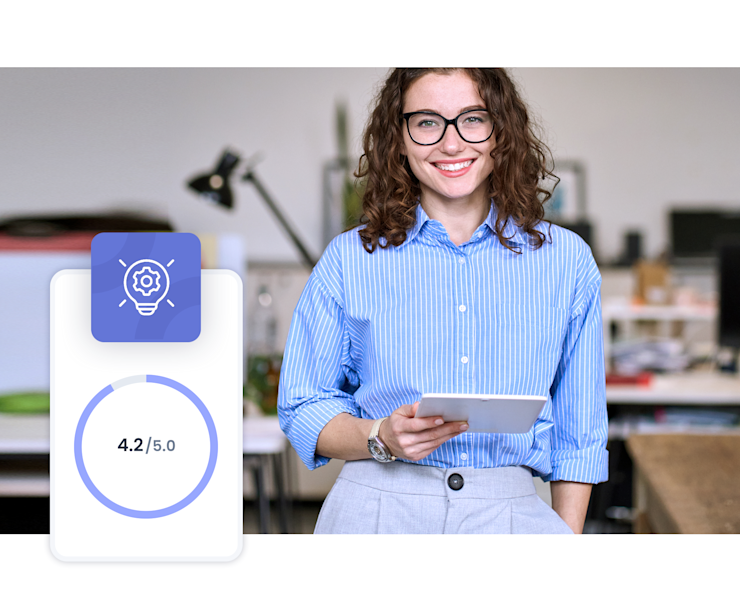Over the past decade, a significant shift has taken place in how companies work with employee engagement. From no surveys to yearly surveys, via pulse surveys, to intelligent employee engagement surveys based on adaptive algorithms and machine learning.
Having tools in place to gather employee feedback has gone from a nice-to-have to an absolute must. And in many cases, a formal channel for feedback and whistleblowing is mandated by law. During this time, a lot has happened on the technical side of employee engagement surveys. And today, we've come a long way.
Let's have a look at the evolution of employee engagement surveys and what the most modern solutions entail today.

The evolution of employee engagement surveys
Over the past decade, the landscape of employee engagement surveys and employee feedback tools has changed drastically. The employee experience has become a much more important focus for leaders and organisations, and today, employee feedback is a core component of almost every HR leader’s people strategy. This also means that the needs and demands for quality data have evolved, as illustrated in the chart below.

From yearly surveys…
The first type of survey that evolved was the annual survey. Those were employee surveys that companies would send out yearly. The questions would sometimes consist of up to a hundred questions, and they were often not in a digital format. Collecting the answers was time-consuming, and analysing the responses was an extensive task. Often, months would pass between HR performing the survey and being ready to act on the results. And with the quick-paced nature of today's workplaces, that would often mean the answers and results were already outdated by then.
...to pulse surveys...
Over time, yearly surveys have increasingly been replaced by more agile methods for gathering feedback that require a lot less manual administration. Enter the pulse surveys, where companies can send out ad-hoc or regular employee engagement surveys more frequently. Digital pulse surveys allow a more agile and data-driven way of working and yield results and insights of much higher quality than their yearly counterparts.
However, standard pulse surveys do come with some challenges and flaws, which is why forward-thinking technology providers didn't stop there. By sending out the same questions repeatedly, pulse surveys can induce survey fatigue that gradually reduces the participation rate. Especially since one of the most essential factors in keeping the workforce engaged is showing that their feedback actually leads to tangible action.
Pulse surveys for employees are definitely a step in the right direction. But only asking your employees the same questions, over and over again, without a structured way of communicating around and acting on the feedback, can actually backfire.
That's why the next generation of employee engagement surveys work in a somewhat different way.
…to survey intelligence powered by machine learning and adaptive algorithms
Instead of sending out the same fixed question battery every time, we can leverage adaptive algorithms and machine learning to create a more dynamic survey sequence. This means that your employees will not receive the same questions again and again. Instead, the questions they receive will depend on their answers in the last survey. This allows the system to spot negative trends and alert managers and HR quickly that there is an issue.
For example, let's say the results indicate that an employee is experiencing stress symptoms. Then the next time this employee receives their survey, it will entail follow-up questions to check if this is still the case – and if things are getting better or worse. This is a valuable tool for quickly locating potential risks and allows organisations, managers, and employees to work proactively to improve the situation.
The whole point is to alert all stakeholders that an area needs attention quickly – before minor issues turn into big problems. But it doesn't stop there. The next step is to connect those insights to action plans.
Related reading: The drivers of employee engagement – and how to measure them

What is the future for intelligent employee surveys?
Thinking about where smart employee surveys are headed means looking at new trends and how they might change the tools we use for keeping employees engaged. Predicting the future is tricky, but some things we've seen recently can give us an idea of what might happen. It's important to know that what happens with tools for engaging employees will depend a lot on what organizations need, how technology keeps moving forward, and how people's work habits change. As workplaces keep changing, the tools we use to engage employees will probably change too, so they fit in better with how people work today. Here are some things that might be important in the future:
Attrition prediction: Anticipating and managing employee turnover is becoming a central focus. Advanced analytics and predictive modelling will enable organisations to forecast attrition trends, empowering proactive strategies for talent retention.
Machine Learning & AI for dynamic survey sequencing: The integration of machine learning and artificial intelligence will elevate the sophistication of survey methodologies. Dynamic survey sequences, personalized based on individual responses and behaviour, will enhance the accuracy and relevance of insights gleaned from these tools.
Customisation & personalisation: Future employee surveys will likely place a premium on customization and personalization. Tailoring survey content to specific roles, departments, or individual preferences will foster a more engaged and responsive workforce.
AI and sentiment analysis: AI and sentiment analysis is revolutionising the interpretation of employee feedback. This nuanced understanding of sentiments expressed in surveys will enable organisations to address issues with greater precision and empathy.
Seamless integrations: The interconnected nature of modern workplaces means that seamless integrations with the broader technological ecosystem are essential. A cohesive approach ensures a unified and efficient user experience across various platforms.
Live insights - real-time data: The shift toward real-time insights is accelarating. Live data feeds and analytics provide organisations with instantaneous feedback, enabling prompt decision-making and agile responses to evolving employee sentiments and needs.
Self-leadership and engagement from within: Employee engagement will extend beyond organisational initiatives to encompass self-leadership. Fostering a culture of self-engagement will empower individuals to take ownership of their professional development, well-being, and overall satisfaction.
As these trends unfold, organisations will be better equipped to foster a workplace environment that not only adapts to change but thrives on continuous improvement and employee well-being.

Connecting insights to actions, and actions to outcomes
Gathering feedback is essential, but it's only when organisations take action on the results that they start reaping the rewards. This, however, can be quite a challenge, both for HR, managers, and employees.
The Eletive platform is built to support communication and a proactive approach at all levels of the organisation. In the tool, both the employees and managers receive in-app advice on what they can do in different scenarios to improve their experience. And in the insights panel, the suggested actions feature provides hands-on support in tangible checklist items to help move things in the right direction. The suggested actions can also be turned into goals (connected to the different engagement drivers) so that it becomes possible to check them off over time – and track the relation between actions and outcomes.
With Eletive, you get access to all the tools you need to measure and increase employee engagement: employee engagement surveys, advice and suggested actions, action plans, one-on-one meetings, 360 surveys, and much more. Get in touch with our team of experts to learn how your organisation could benefit from a modern employee engagement tool!
FAQ
What is the purpose of employee engagement surveys?
The purpose of employee engagement surveys is to collect feedback from employees in order to gain insights into their experience and to identify areas of improvement for the organisation.
How have employee engagement surveys evolved over the past decade?
Employee engagement surveys have evolved from yearly surveys with long questionnaires to more agile pulse surveys, and now to surveys powered by machine learning and adaptive algorithms.
What are the benefits of using intelligent employee engagement surveys?
The benefits of using intelligent employee engagement surveys include the ability to spot negative trends quickly, the ability to ask follow-up questions based on responses, and the ability to connect insights to action plans.

























